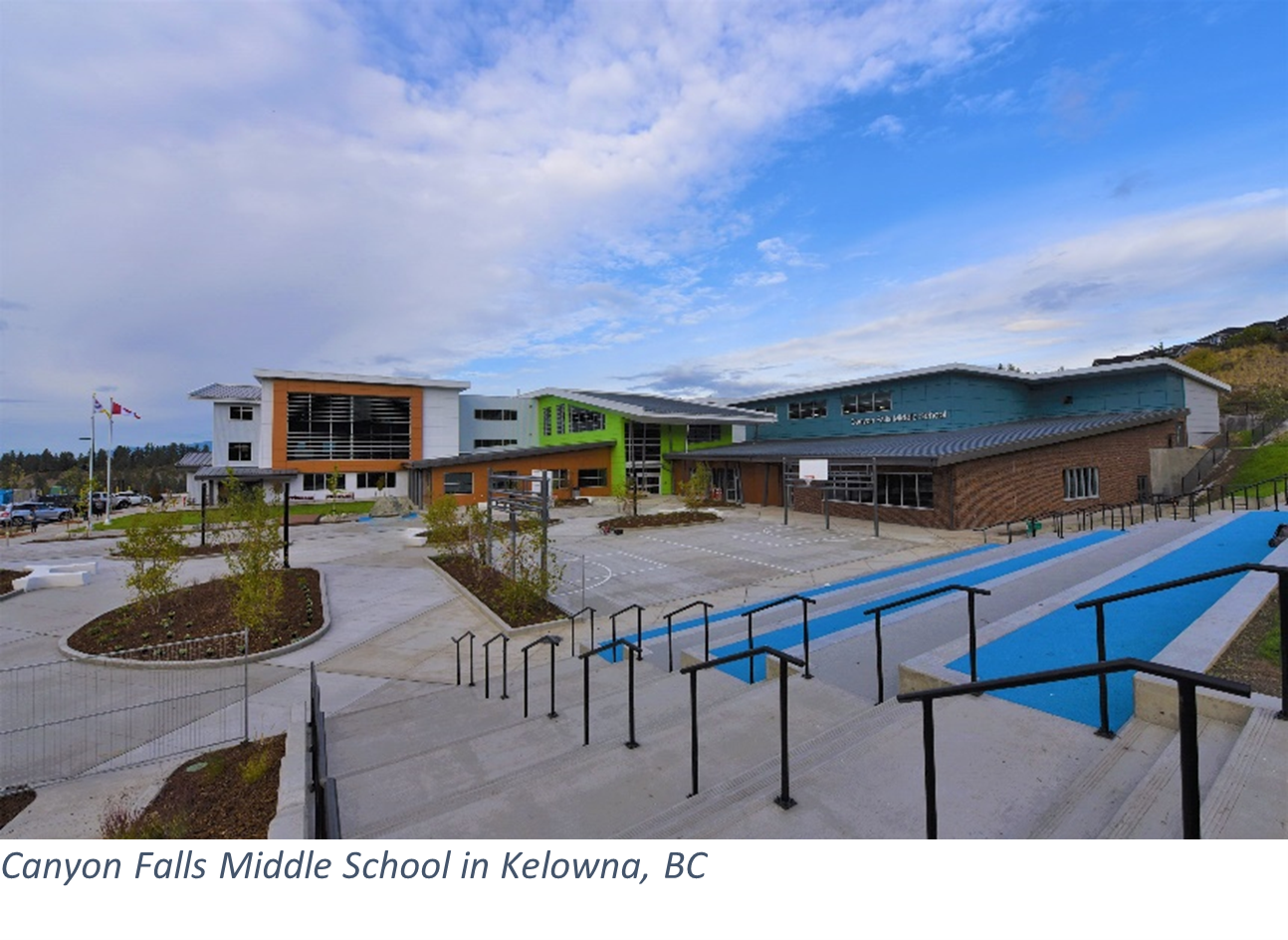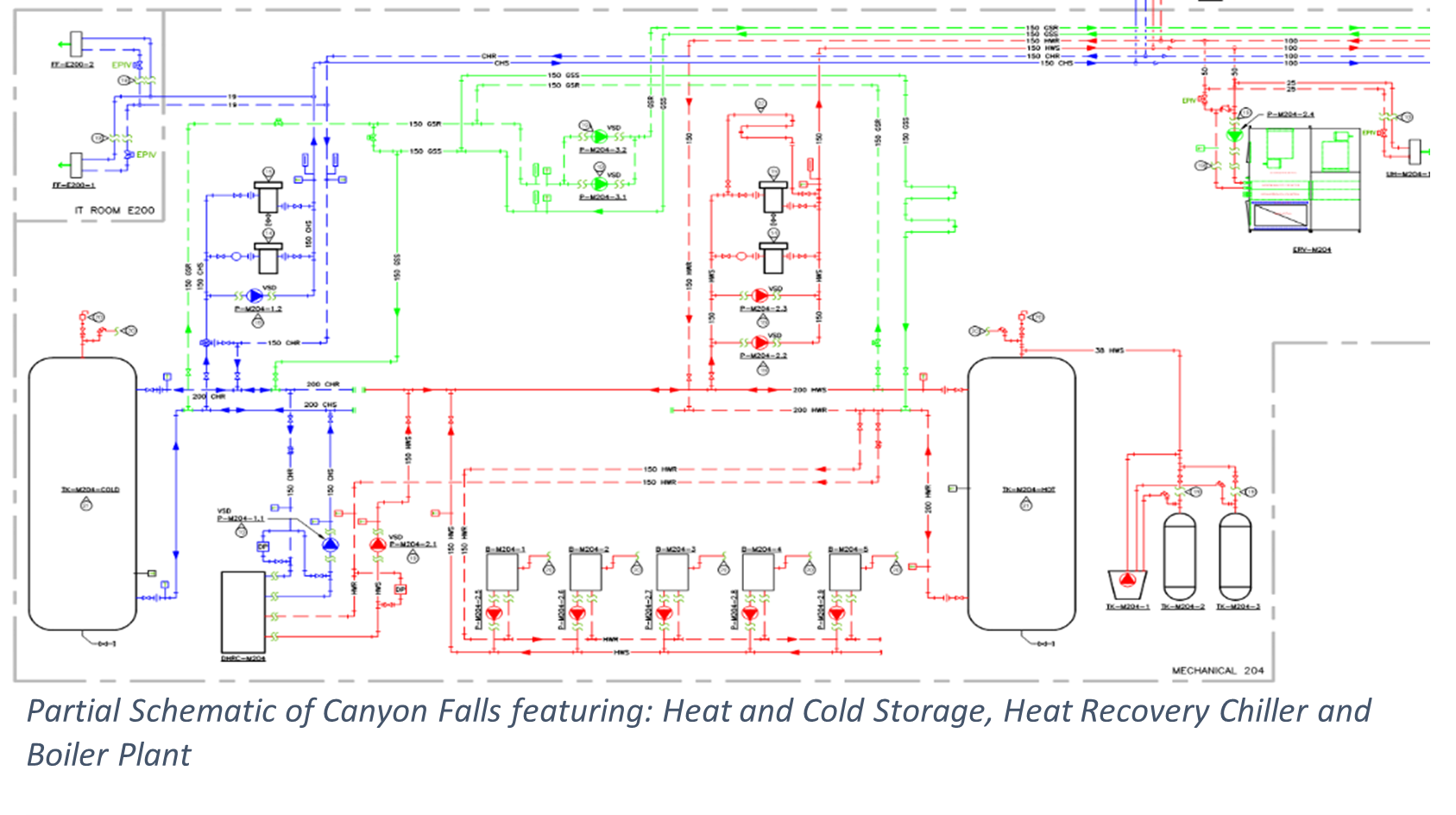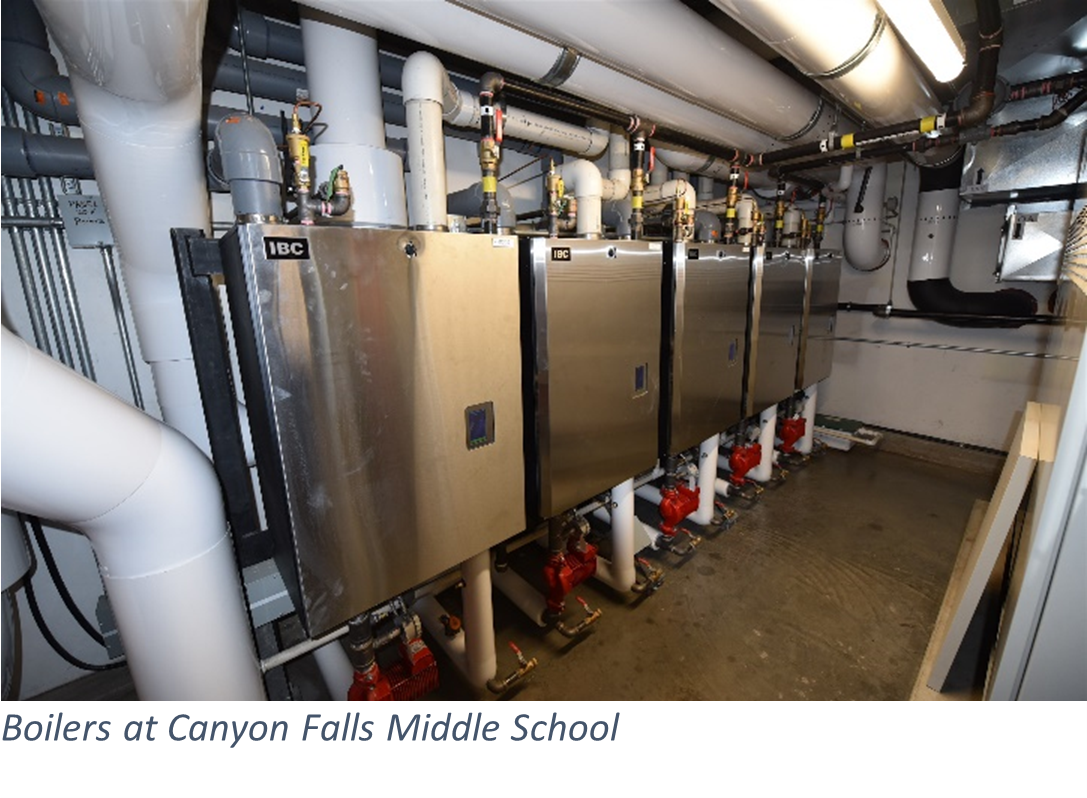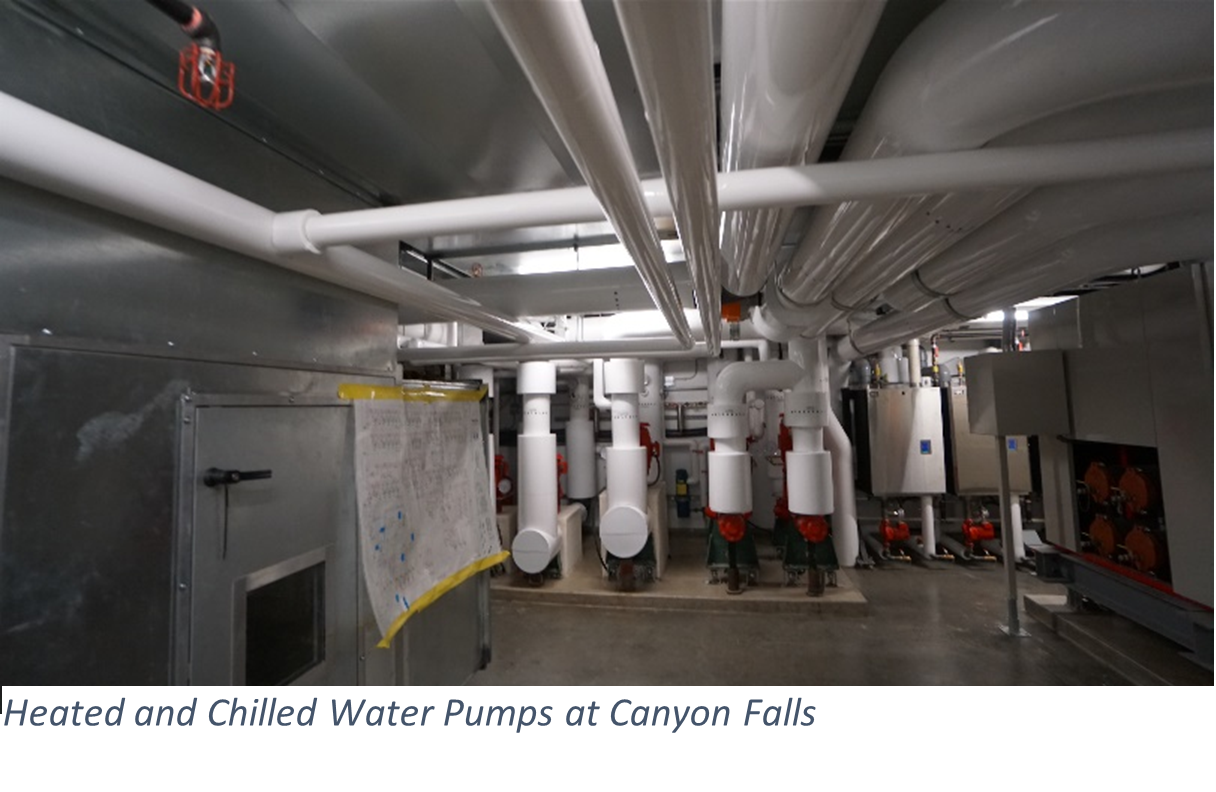If you think that the design of an HVAC system, utilizing primary energy derived from a geoexchange source, is usually overly complex and is often unsuccessful in reducing energy consumption or Greenhouse Gases emissions, this mechanical design by Falcon Engineering will surprise you!
Introduction
The ‘dream’ of a newly designed public school featuring an affordable HVAC system, with characteristics of very low energy consumption, very low volumes of Greenhouse Gases (GHG) emissions, and which performs consistently and reliably with simple operations and reduced learning curve for operational personnel, is now a reality. Falcon Engineering’s Mechanical Engineering department has achieved that dream, and its latest iteration is constructed within School District 23’s Canyon Falls Middle School in Kelowna, BC. Canyon Falls Middle School was completed in 2019 and, following the lifting of COVID-19 restrictions and protocols, has now performed through a full school educational year operation.

The HVAC system at Canyon Falls needed to meet the School District’s 21st Century Learning Concepts within its mechanical design. It demands that the HVAC system not only serves the ventilation and comfort requirements of each individual classroom, gymnasium, and support spaces, but also must meet the demands imposed by flexible wall structures, larger occupant loads within enlarged spaces, and cooperative learning opportunities (classes melded temporarily to cooperate in lessons and experiences).
Additionally, School District 23 required the HVAC engineering design to meet the Province of BC’s carbon emissions goals, resulting in the new school being designed to meet LEED Gold Standards.
The resultant HVAC design by Falcon’s Mechanical Design Group, led by Andrew Springer, P. Eng., is based on a four-pipe fan coil system, featuring primary energy drawn from a vertical loop geoexchange system, also designed by Falcon. The design of the geoexchange system itself encountered potentially difficult ground conditions, so the Energy Engineering Group at Falcon elected an innovative design concept where a smaller number of deeper boreholes were employed to increase capacity per unit of borehole length.

The HVAC thermal plant design includes the use of a heat recovery chiller featuring unique and custom control sequences designed jointly by Falcon and the equipment manufacturer. This measure reduced the resultant plant complexity and resulted in a system that operates efficiently and without surprises for plant operators and maintainers.
Outdoor air systems feature the use of reversing flow heat recovery equipment, benefitting from efficient waste heat extraction and recovery, as well as the elimination of inherent condensation and icing problems.
Finally, Falcon’s Electrical Engineering design included a complete LED lighting installation, along with addressable lighting controls. The resultant lighting system operates at 35% less consumption than required by Building Code Requirements, and the installed lighting control system offers even greater energy savings in the future. A solar photovoltaic array, installed on the roof of the multipurpose atrium, rounds out the energy-conserving and GHG-avoiding design, to further offset the building’s electricity consumption.
Energy Conservation and GHG Emissions
Recently reported Energy Use Intensity (EUI) of Canyon Falls indicates a Building Energy Performance Indicator (BEPI) of 61ekWh/m2yr of the combined total of natural gas and electricity consumption. This figure is well below the Canadian average BEPI of 244ekWh/m2yr for K-12 schools.
Electricity consumption, alone, is reported to be 52 kWh/m2yr which is the lowest in the District, where the District-wide average is 112 kWh/m2yr. This demonstrates, too, that the natural gas component of the total EUI is just 9ekWh/m2yr, largely representing domestic hot water energy consumption, and that performance, in turn, demonstrates the value of deriving the primary energy for the HVAC design from a successful geoexchange system.

GHG emissions are reported at 19 tonnes of CO2e/yr, or 2 kg/m2yr. And compared to School District 23 averages, Canyon Falls’ additional carbon reduction is equivalent to 37 passenger cars off the road each year, or to the planting and growth of 28,700 trees over 10 years.
How the HVAC Design Supports the School District’s 21st-Century Learning Concepts

As HVAC designers and users will well appreciate, designing an HVAC system to meet standard requirements for individual regular classrooms and to also meet the ventilation and comfort (temperature) requirements of a much larger area when flexible walls are moved apart, suggests the use of a complex HVAC system and suggests, also, that occupants might have to tolerate sub-standard performance characteristics in one classroom configuration or another. The flexible walls between classrooms and multi-use areas are integral to the 21st Century Learning Concepts of School District 23, for periodically accommodating larger groups of school children collaborating within the enlarged spaces normally separated by walls.
Not so, with this HVAC engineering design by Falcon! The four-pipe fan coil systems in each classroom, multi-use area, and other occupancies, supports the varying demands imposed by alternate wall configurations, providing reliable and comfortable conditions whether configured in standard classroom configuration, or larger collaboration configurations.
A Reliable and Simple HVAC Design
The installation of the HVAC design by Falcon at Canyon Falls has been described by School District 23 operators and maintainers as easy to understand, easy to maintain, and simple to operate. Utilizing innovations in design, as described above, collaborations with equipment manufacturers, and a purposeful drive for simplicity in design, Falcon has delivered an HVAC engineering design that meets (maybe even exceeds) the needs and expectations of the School District’s system operators and maintainers.
The School District’s Point of View
Mr. Harold Schock, Central Okanagan Public Schools’ Energy & Sustainability Manager, when asked for his opinions on the statements within this blog, had these comments to make:
“[The Province of] BC has legislated targets for reducing greenhouse gas emissions 40% below 2007 levels by 2030, 60% by 2040, and 80% by 2050. The Province also has an interim target to reduce emissions by 16% by 2025. At Canyon Falls Middle School (CFMS), [the design] has performed at the highest level of GHG avoidance. Meeting and exceeding the Provincial challenge of 80% GHG reduction target without adding to the total utility cost.”
Further, Mr. Schock reported that “At CFMS, total energy needed for a full year [of operation] is only 0.40Gj/m2. CFMS has earned an Energy Star Rating of 100% for three years in a row.”
And Mr. Schock ended his comments with the following statement, “Falcon Engineering Team’s primary focus [in the CFMS design] is to move heat energy efficiently. Rather than creating & wasting heat energy.”
Conclusion
Going back to the opening statement of implied complexity of HVAC designs utilizing geoexchange as their primary energy source, Falcon Engineering’s Mechanical Engineering Group has demonstrated at a variety of projects, including Canyon Falls Middle School, that their systems design may be more factually described as “high on the sophistication scale, while low on the complexity scale.” It is this sophistication in design that has resulted in an overall successful consumption-reducing, GHG-avoiding, comfortable and reliable system, designed to be flexible for school occupants and simultaneously easily operated and maintained by School District 23 employees over the lives of the systems within the school. All that, plus energy conservation and Greenhouse Gases emissions reductions, too!
If you would like to find out how we can help with the HVAC design for your project, get in contact by using our contact page.

You can find out more about our Energy Engineering services here and more about our team.
If you have questions about our experience or the HVAC system work we do, get in contact by using our contact page.
Want to learn more about energy engineering? Check out some of our other blogs!